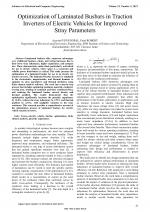| 2/2023 - 10 |
Optimization of Laminated Busbars in Traction Inverters of Electric Vehicles for Improved Stray ParametersVENUGOPAL, A. |
| Extra paper information in |
| Click to see author's profile in |
| Download PDF |
Author keywords
electric vehicle, busbar, optimization, finite element analysis, parasitic capacitance
References keywords
power(19), laminated(15), busbar(14), electronics(10), design(10), inductance(8), ecce(8), stray(7), busbars(5), analysis(5)
Blue keywords are present in both the references section and the paper title.
About this article
Date of Publication: 2023-05-31
Volume 23, Issue 2, Year 2023, On page(s): 85 - 92
ISSN: 1582-7445, e-ISSN: 1844-7600
Digital Object Identifier: 10.4316/AECE.2023.02010
Web of Science Accession Number: 001009953400010
SCOPUS ID: 85164342866
Abstract
Laminated busbars offer numerous advantages over traditional busbars, cables, and wiring harnesses due to their lower stray inductance, higher capacitance, and compact size. These characteristics make them particularly well-suited for use in electric vehicles, where space is a constraint and reliable power distribution is critical. This study presents the optimization of a laminated busbar for use in an electric car traction inverter. The laminated busbar structure is simulated in the electrostatic, magnetostatic, and thermal domains to optimize its stray parameters and thermal attributes using finite element analysis software. The work has a step-by-step process that includes optimizing insulation material, conductor overlap area, bending of terminals and their combined effect, and reducing the laminated busbar current density and thermal gradient. The results demonstrate that the optimization significantly increases the parasitic capacitance by 14.8%, reduces the stray inductance by 2.73% and thermal gradient by 2.34%, with negligible variation in the stray resistance. This research provides a comprehensive account of the optimization process of laminated busbars for electric vehicle traction inverters. |
| References | | | Cited By |
Web of Science® Times Cited: 1 [View]
View record in Web of Science® [View]
View Related Records® [View]
Updated 3 weeks, 5 days ago
SCOPUS® Times Cited: 1
View record in SCOPUS® [Free preview]
View citations in SCOPUS® [Free preview]
[1] Numerical investigation and thermal optimization of low-inductance ring-shaped film capacitors with integrated cooling structure for electric vehicle, Wang, Yi, Guo, Hui, Yuan, Tao, Wang, Yansong, Guo, Xinhua, Shi, Wei, Zhao, Lihui, Huang, Linhao, Proceedings of the Institution of Mechanical Engineers, Part D: Journal of Automobile Engineering, ISSN 0954-4070, 2024.
Digital Object Identifier: 10.1177/09544070241302398 [CrossRef]
Disclaimer: All information displayed above was retrieved by using remote connections to respective databases. For the best user experience, we update all data by using background processes, and use caches in order to reduce the load on the servers we retrieve the information from. As we have no control on the availability of the database servers and sometimes the Internet connectivity may be affected, we do not guarantee the information is correct or complete. For the most accurate data, please always consult the database sites directly. Some external links require authentication or an institutional subscription.
Web of Science® is a registered trademark of Clarivate Analytics, Scopus® is a registered trademark of Elsevier B.V., other product names, company names, brand names, trademarks and logos are the property of their respective owners.
Faculty of Electrical Engineering and Computer Science
Stefan cel Mare University of Suceava, Romania
All rights reserved: Advances in Electrical and Computer Engineering is a registered trademark of the Stefan cel Mare University of Suceava. No part of this publication may be reproduced, stored in a retrieval system, photocopied, recorded or archived, without the written permission from the Editor. When authors submit their papers for publication, they agree that the copyright for their article be transferred to the Faculty of Electrical Engineering and Computer Science, Stefan cel Mare University of Suceava, Romania, if and only if the articles are accepted for publication. The copyright covers the exclusive rights to reproduce and distribute the article, including reprints and translations.
Permission for other use: The copyright owner's consent does not extend to copying for general distribution, for promotion, for creating new works, or for resale. Specific written permission must be obtained from the Editor for such copying. Direct linking to files hosted on this website is strictly prohibited.
Disclaimer: Whilst every effort is made by the publishers and editorial board to see that no inaccurate or misleading data, opinions or statements appear in this journal, they wish to make it clear that all information and opinions formulated in the articles, as well as linguistic accuracy, are the sole responsibility of the author.



